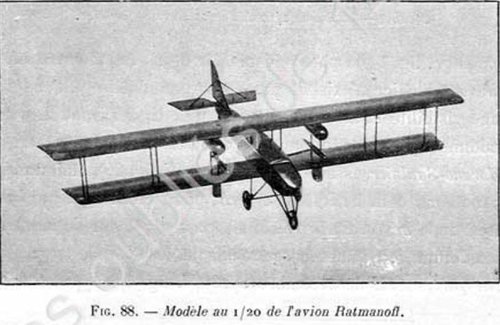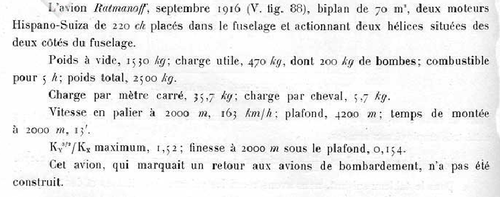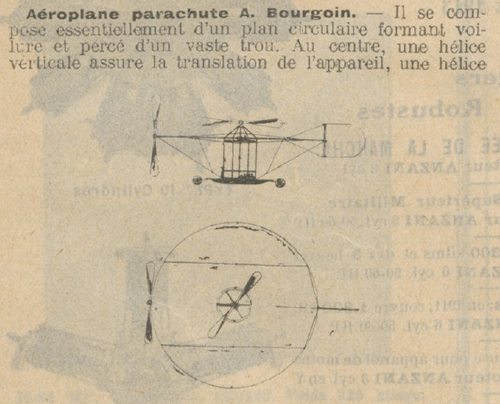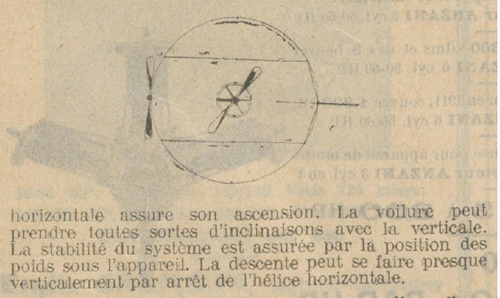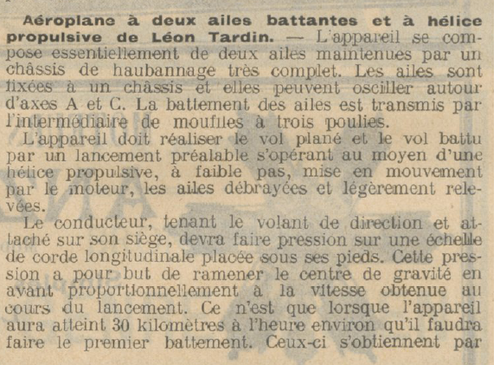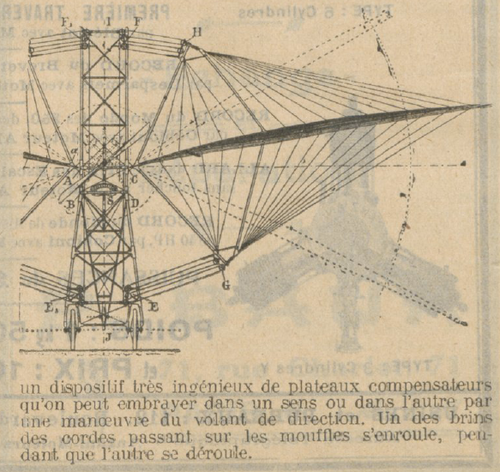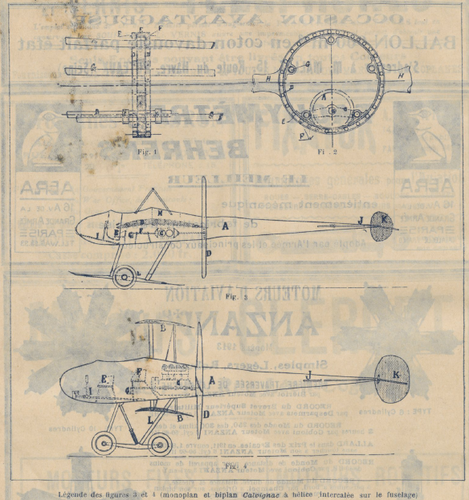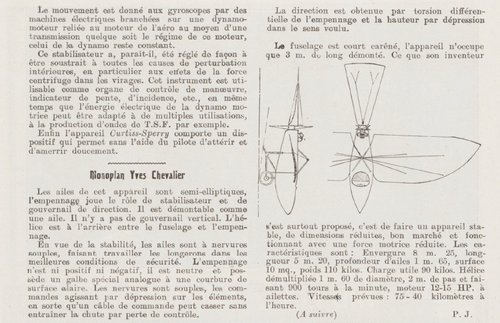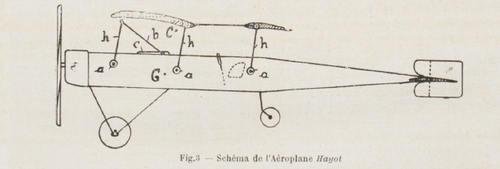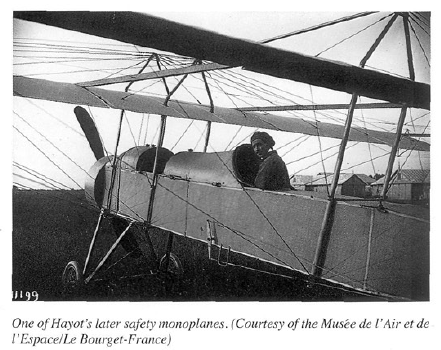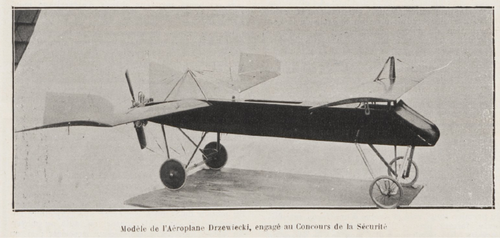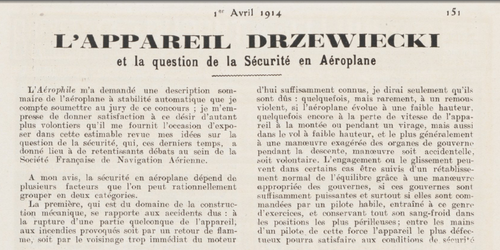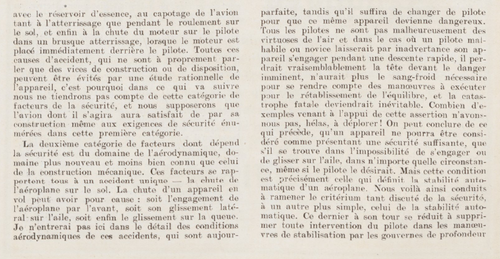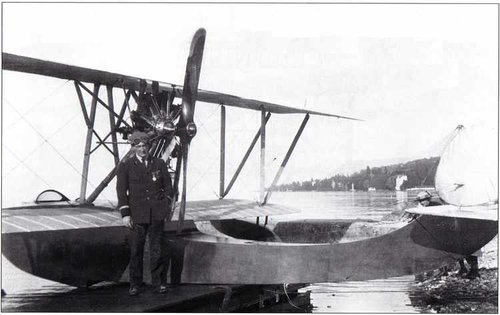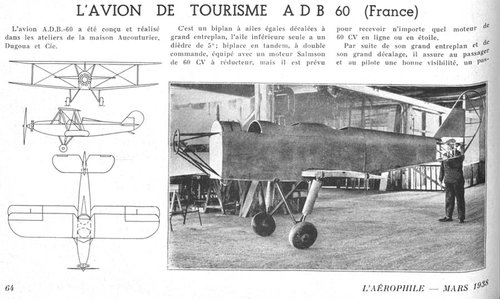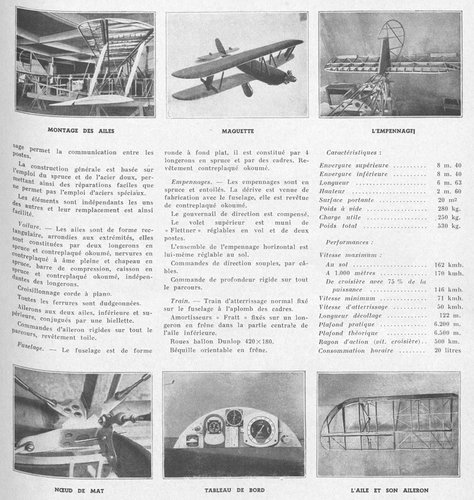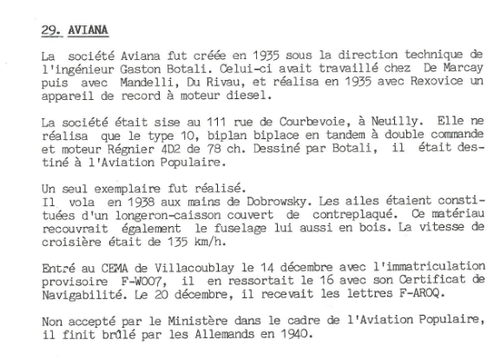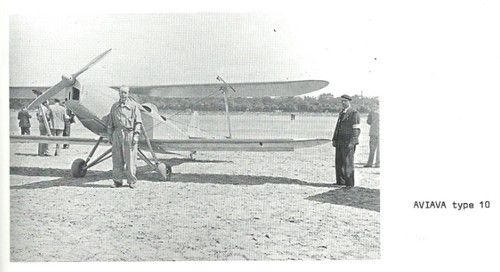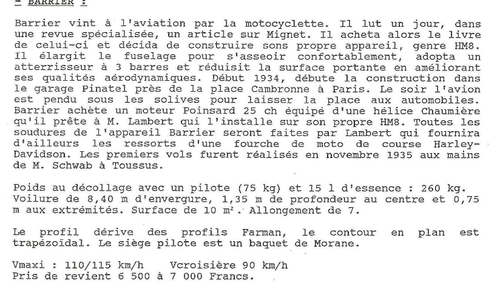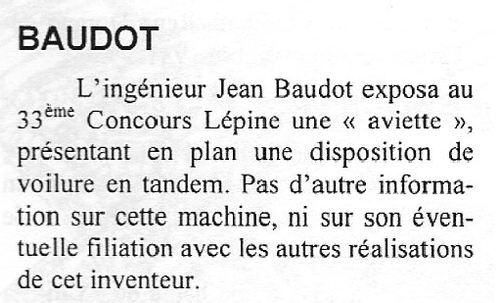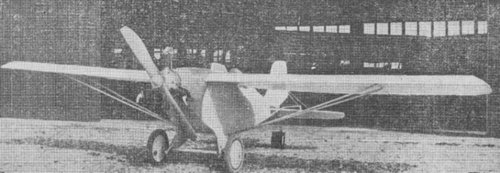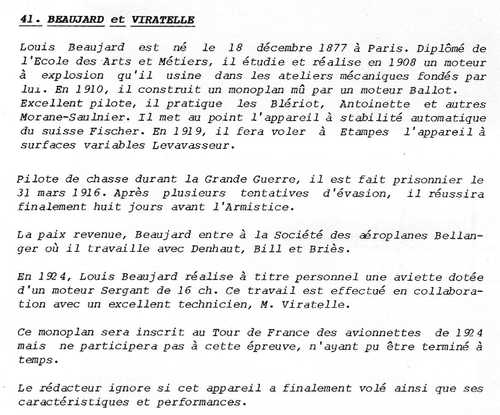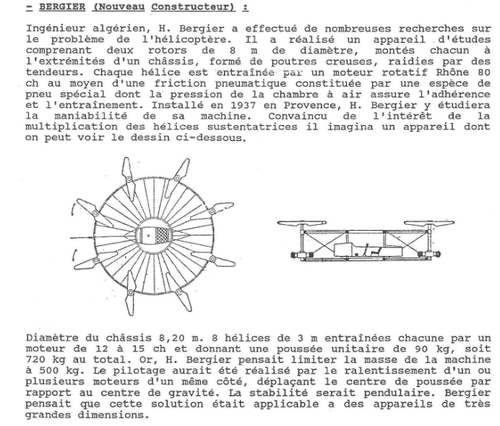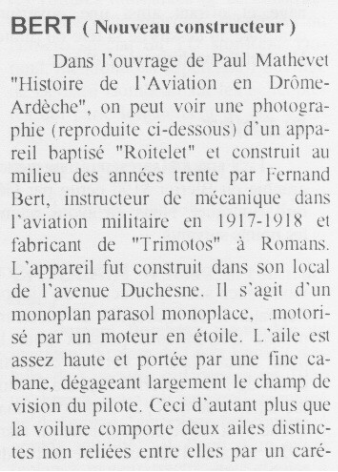You are using an out of date browser. It may not display this or other websites correctly.
You should upgrade or use an alternative browser.
You should upgrade or use an alternative browser.
Little-Known French Projects and Prototypes
- Thread starter hesham
- Start date
Aubi
ACCESS: Secret
Despite the name, Pierre de Ratmanoff (or maybe Pyotr Ratmanov?) was French entrepreneur and his company Ratmanoff & Cie in Suresnes manufactured the "Normale" propellers according to patents of Polish engineer Stefan Drzewiecki. It seems that in 1917 his company was the third largest manufcturer of propellers in France, and also that he like Levasseur tried to move into aircraft manufacturing (but without succes). He's mentioned in French Aicraft Before the Great War as manufacturer of at least two de Beer monoplanes and at least two two-seater monoplanes of his own design.
- Joined
- 26 May 2006
- Messages
- 34,901
- Reaction score
- 15,776
- Joined
- 26 May 2006
- Messages
- 34,901
- Reaction score
- 15,776
No french, but american airplane. Moisant Company, designed by M.Harold Kastner.
Thank you,and I will change the post by anther French designer
Last edited:
- Joined
- 25 July 2007
- Messages
- 4,299
- Reaction score
- 4,196
...
ALE means, Aviation Légère Economique
ADB means, Société Aucouturier Dugoua et Cie ...
Despite the ONERA entry, ADB wasn't a short form for Aucouturier, Dugoua et Cie. It was a designation style. The listing on page 43 mistakenly lists Constructeur as "A.D.B." and the Modèle as "60". They are, of course, referring to the ADB 60 (based on its 60 cv Salmson radial rating).
Since an alternative designation for the ADB 60 biplane tourer was AD 1, I presume that the 'B' was the designers initial. The firm is sometimes listed as Aucouturier, Dugoua & Cie (Leopoldoff) while it produced the Leopoldoff L.3 Colibri light biplane trainers.
I suspect that 'Aviation Légère Économique' is not a corporate name but, rather, a general description of the E.20 type tested in the wind tunnel.
BTW, for the J.V.5., I believe that "à flotteurs repliables refers to retractable floats.
- Joined
- 26 May 2006
- Messages
- 34,901
- Reaction score
- 15,776
Thank you my dear Apophenia for illuminate me,
and also from Aerophile 1914,here is a tandem wing monoplane for Captain Hayot,which I spoke before
about it here;
and also from Aerophile 1914,here is a tandem wing monoplane for Captain Hayot,which I spoke before
about it here;
Attachments
- Joined
- 25 July 2007
- Messages
- 4,299
- Reaction score
- 4,196
Your link shows Louis Adolphe Hayot's one-off multiplane (built by Lucien Chauvière) and tested near Beauvais in the spring of 1909. The illustrations above are of one of four 2-seater 'double monoplanes' developed by Captain Hayot from 1912 to 1914. The object of the latter was providing automatic stability.
"The other 4 designs were all 2-seat tandem-wing monoplanes; the high parasol rear wing was set close behind the high parasol front wing, at a lower angle of attack. All 4 had rear monoplane elevators and single rudders. The positions of the wings in these 4 designs moved further and further forward, the pilot always below the rear wing and the passenger/mechanic below and to the rear of the forward wing. Descriptions of Hayot's device remain unclear. The wings were mounted on frames which oscillated freely fore and aft on the sides of the fuselage to damp oscillations of the machine between 2 stable positions. It appears that the inventor was pleased with the lack of sensitivity of his controls, and that he continuously increased the power of his machines from 50 to 100 hp, at the same time reducing their weight."
French Aeroplanes Before the Great War, Leonard E. Opdycke, Schiffer Military History, 2004, page 150.
Of the tandem wings, the rear set was smaller and had a lesser angle of attack. The support posts pivoted at either end, allowing the wing panels to pivot back and forth. Wing movement was limited by weights.
"The tandem planes act as a brake against pitching, and the longitudinal "V" promotes stability. The machine passes from one position of equilibrium to another, under control of pilot, without oscillation; small inadvertent movements of the controls are without appreciable effect. The position of the pilot below the wings facilitates vision and helps in landing.
An apparatus of this type is now under construction. Its dimensions are: Surface, 35 sq. m.; spread, 13 m., total length, 8.65 m. ; weight, empty, 550 kg.; useful load, 450 kg.; power, 100; speed expected, 115 km. per hour."
Aeronautics, June 1913, page 118
-- https://archive.org/stream/aeronautics1314aero/aeronautics1314aero_djvu.txt
A couple of other views.
-- http://flyingmachines.ru/Images7/Aerodrome/439-1.jpg
-- http://flyingmachines.ru/Images7/Aerodrome/439.jpg
'Automatic stabilizing apparatus for aeroplanes.' Louis Adolphe Hayot
- Filed 13 Aug 1912, grated US patent 21 Sept 1915
-- https://patents.google.com/patent/US1154396
Louis Adolphe Hayot. Beauvais, France, 976,S76, Nov. 29, 1910. Filed Aug. 31, 1909. AEROPLANE. Automatic equilibrium by dihedral wings jointed at the shoulder, moving forward and back in a horizontal plane.
'Ejector for apparatus for sustaining and propelling aeroplanes and for other uses.'
- Filed 18 Feb 1913 by Louis Adolphe Hayot, US patent granted 18 Aug 1913
-- https://patents.google.com/patent/US1069694A/en
"The other 4 designs were all 2-seat tandem-wing monoplanes; the high parasol rear wing was set close behind the high parasol front wing, at a lower angle of attack. All 4 had rear monoplane elevators and single rudders. The positions of the wings in these 4 designs moved further and further forward, the pilot always below the rear wing and the passenger/mechanic below and to the rear of the forward wing. Descriptions of Hayot's device remain unclear. The wings were mounted on frames which oscillated freely fore and aft on the sides of the fuselage to damp oscillations of the machine between 2 stable positions. It appears that the inventor was pleased with the lack of sensitivity of his controls, and that he continuously increased the power of his machines from 50 to 100 hp, at the same time reducing their weight."
French Aeroplanes Before the Great War, Leonard E. Opdycke, Schiffer Military History, 2004, page 150.
Of the tandem wings, the rear set was smaller and had a lesser angle of attack. The support posts pivoted at either end, allowing the wing panels to pivot back and forth. Wing movement was limited by weights.
"The tandem planes act as a brake against pitching, and the longitudinal "V" promotes stability. The machine passes from one position of equilibrium to another, under control of pilot, without oscillation; small inadvertent movements of the controls are without appreciable effect. The position of the pilot below the wings facilitates vision and helps in landing.
An apparatus of this type is now under construction. Its dimensions are: Surface, 35 sq. m.; spread, 13 m., total length, 8.65 m. ; weight, empty, 550 kg.; useful load, 450 kg.; power, 100; speed expected, 115 km. per hour."
Aeronautics, June 1913, page 118
-- https://archive.org/stream/aeronautics1314aero/aeronautics1314aero_djvu.txt
A couple of other views.
-- http://flyingmachines.ru/Images7/Aerodrome/439-1.jpg
-- http://flyingmachines.ru/Images7/Aerodrome/439.jpg
'Automatic stabilizing apparatus for aeroplanes.' Louis Adolphe Hayot
- Filed 13 Aug 1912, grated US patent 21 Sept 1915
-- https://patents.google.com/patent/US1154396
Louis Adolphe Hayot. Beauvais, France, 976,S76, Nov. 29, 1910. Filed Aug. 31, 1909. AEROPLANE. Automatic equilibrium by dihedral wings jointed at the shoulder, moving forward and back in a horizontal plane.
'Ejector for apparatus for sustaining and propelling aeroplanes and for other uses.'
- Filed 18 Feb 1913 by Louis Adolphe Hayot, US patent granted 18 Aug 1913
-- https://patents.google.com/patent/US1069694A/en
- Joined
- 26 May 2006
- Messages
- 34,901
- Reaction score
- 15,776
Hi,
the Aiglon-Roulier designed a single seat fighter flying boat biplane in 1917,powered by one
130 hp Clerget 9B engine,not even mentioned in the book; French Aircraft of the First World
War ?.
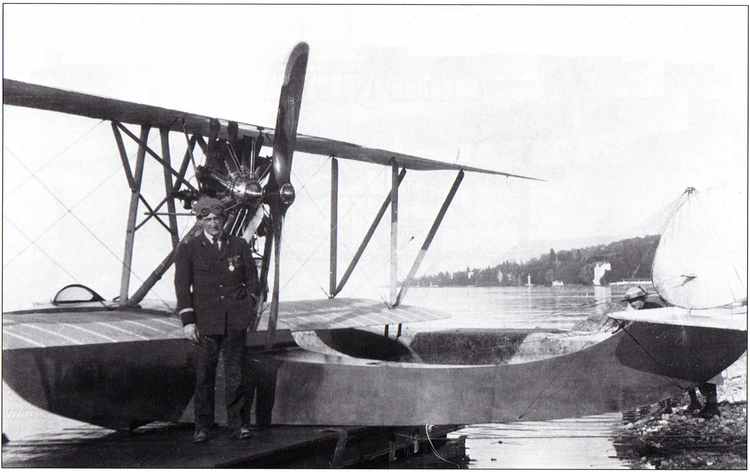
 www.aviationsmilitaires.net
www.aviationsmilitaires.net
the Aiglon-Roulier designed a single seat fighter flying boat biplane in 1917,powered by one
130 hp Clerget 9B engine,not even mentioned in the book; French Aircraft of the First World
War ?.

Aiglon Aiglon-Roulier
Prototype d'hydravion de chasse français de la seconde guerre mondiale.
Attachments
- Joined
- 25 July 2007
- Messages
- 4,299
- Reaction score
- 4,196
Initial design work on what became the Aiglon-Roulier was begun in 1914 before EV 1 Jean Roulier was even accepted for flight training. The following is from CAM de Venise - Les escadrilles françaises:
"Heureux dans l'action, Jean est aussi un esprit inventif. Dès 1914, il fait les plans d'un hydravion de chasse, jugé par la marine comme une avancée technologique importante. C'est à Venise qu'il pourra en parfaire les plans. En juin 1916, il raconte à son frère : 'Les Italiens nous ont fait des propositions écrites pour construire à Venise, probablement dans un chantier privé, mon appareil'."
Quoted by Bernard Roulier in his 2000 reminscences: http://albindenis.free.fr/Site_escadrille/CAM_Venise.htm
Translating something like: "Content in action, Jean was also an inventive spirit. In 1914, he made design for a fighter seaplane, judged by the navy as an important technological advance. He perfected his plans in Venice. In June 1916, he told his brother: 'The Italians made us written proposals to build my design in Venice, probably in a private shipyard'."
So, it sounds like the Italians were considering building Roulier's hydravion de chasse design before deciding upon Macchi-built Lohner copies instead.
OT: I've seen a reference to Jean Roulier as lieutenant de vaisseau. Most sources list him as an Enseigne de vaisseau de 1ère classe at the time of his death in August 1916. Does anyone know if Roulier was an EV 1 raised to LV 1 posthumously?
BTW, I've also seen online refs to his death in action as 17 Aug 1916 (along with his "Mécanicien Mitrailleur", Costerousse). Actually, Roulier's final attack on Trieste had occurred on 15 Aug 1916. Since the aircraft (FBA 150, n°308) was carrying bombs, QM (Quartier-Maître) Costerousse would have been acting as observateur not gunner. Roulier was shot down over Trieste harbour by a Lohner M (L 16) flown by Gottfried Freiherr von Banfield. The body of EV 1 Jean Jules Henri Roulie was recovered by an Italian torpedo boat soon after the crash. AFAIK, the body of QM Auguste Henri Costerousse was never recovered (or, at least, not identified).
"Heureux dans l'action, Jean est aussi un esprit inventif. Dès 1914, il fait les plans d'un hydravion de chasse, jugé par la marine comme une avancée technologique importante. C'est à Venise qu'il pourra en parfaire les plans. En juin 1916, il raconte à son frère : 'Les Italiens nous ont fait des propositions écrites pour construire à Venise, probablement dans un chantier privé, mon appareil'."
Quoted by Bernard Roulier in his 2000 reminscences: http://albindenis.free.fr/Site_escadrille/CAM_Venise.htm
Translating something like: "Content in action, Jean was also an inventive spirit. In 1914, he made design for a fighter seaplane, judged by the navy as an important technological advance. He perfected his plans in Venice. In June 1916, he told his brother: 'The Italians made us written proposals to build my design in Venice, probably in a private shipyard'."
So, it sounds like the Italians were considering building Roulier's hydravion de chasse design before deciding upon Macchi-built Lohner copies instead.
OT: I've seen a reference to Jean Roulier as lieutenant de vaisseau. Most sources list him as an Enseigne de vaisseau de 1ère classe at the time of his death in August 1916. Does anyone know if Roulier was an EV 1 raised to LV 1 posthumously?
BTW, I've also seen online refs to his death in action as 17 Aug 1916 (along with his "Mécanicien Mitrailleur", Costerousse). Actually, Roulier's final attack on Trieste had occurred on 15 Aug 1916. Since the aircraft (FBA 150, n°308) was carrying bombs, QM (Quartier-Maître) Costerousse would have been acting as observateur not gunner. Roulier was shot down over Trieste harbour by a Lohner M (L 16) flown by Gottfried Freiherr von Banfield. The body of EV 1 Jean Jules Henri Roulie was recovered by an Italian torpedo boat soon after the crash. AFAIK, the body of QM Auguste Henri Costerousse was never recovered (or, at least, not identified).
- Joined
- 26 May 2006
- Messages
- 34,901
- Reaction score
- 15,776
From l'Aeronautique 12/1937,
the designer Joseph Touya created a single seat low-wing tourist aircraft project,
all details are in the picture,it is not mentioned in TU magazine.
This designer also built a glider in 1931,with an area of 14m,was flight in 1934.
- Joined
- 25 July 2007
- Messages
- 4,299
- Reaction score
- 4,196
That would be the 1932 SBT - after designers Paul Saboureault, Edouard Bouissière, and Joseph Touya. SBT was a basic trainer glider with a wing area of 14 m2 and span 31.10 m.
- Joined
- 26 May 2006
- Messages
- 34,901
- Reaction score
- 15,776
ALE means, Aviation Légère Economique
ADB means, Société Aucouturier Dugoua et Cie
but what was J.V. and SFAM ?.
The ADB.60 was a biplane with equal wings, positive offset, fins on both
plans, compensated steering flap and trihedral train.
Attachments
Last edited:
- Joined
- 25 July 2007
- Messages
- 4,299
- Reaction score
- 4,196
- Joined
- 26 May 2006
- Messages
- 34,901
- Reaction score
- 15,776
Thank you my dear Apophenia,
and I hope to solve the SFAM mystery.
Mr. Léon Bare in 1933,from Marthureux-sur-Saône, built an airplane Mignet formula with a wingspan of 10 m,
depth 1.30 m. The weight of the glider is 87 kg. With the Indian 9 hp engine, the change speed and propeller,
you get to 186 kg. The first one was to take place in the summer of 1933.
and I hope to solve the SFAM mystery.
Mr. Léon Bare in 1933,from Marthureux-sur-Saône, built an airplane Mignet formula with a wingspan of 10 m,
depth 1.30 m. The weight of the glider is 87 kg. With the Indian 9 hp engine, the change speed and propeller,
you get to 186 kg. The first one was to take place in the summer of 1933.
Attachments
Last edited:
- Joined
- 25 July 2007
- Messages
- 4,299
- Reaction score
- 4,196
"Marthureux-sur-Saêne" should read Monthureux-sur-Saône. Also, I believe that "avec le changement de vitesse" refers to a change to gearing not "speed". Could a native French-speaker help out here?
Another question for francophones: Marthureux s/saône shows up in a handful of online search with dates in the 19th Century. Google keeps prompting 'Monthureux-sur-Saône'. Any actual relationship between Monthureux-sur-Saône and the similar-looking Marthureux-sur-Saône?
Another question for francophones: Marthureux s/saône shows up in a handful of online search with dates in the 19th Century. Google keeps prompting 'Monthureux-sur-Saône'. Any actual relationship between Monthureux-sur-Saône and the similar-looking Marthureux-sur-Saône?
- Joined
- 3 September 2006
- Messages
- 1,475
- Reaction score
- 1,472
Yes, changement de vitesse means gearbox. Maybe including clutch, too.I believe that "avec le changement de vitesse" refers to a change to gearing not "speed". Could a native French-speaker help out here?
- Joined
- 26 May 2006
- Messages
- 34,901
- Reaction score
- 15,776
From TU 136,
here is a Type-10 from Aviana.
here is a Type-10 from Aviana.
Attachments
Last edited:
- Joined
- 26 May 2006
- Messages
- 34,901
- Reaction score
- 15,776
From TU 185;
in the 1920s (before 1928),René Barrelier, future co-founder of the Aéro-Club de la Sarthe
(then called Light Aviation Club Wright - Léon - Bollée} had built a small plane with young
amateurs. The editor ignores everything except that this machine left one day alone and
stopped after a few meters on an apple tree.
in the 1920s (before 1928),René Barrelier, future co-founder of the Aéro-Club de la Sarthe
(then called Light Aviation Club Wright - Léon - Bollée} had built a small plane with young
amateurs. The editor ignores everything except that this machine left one day alone and
stopped after a few meters on an apple tree.
Attachments
- Joined
- 26 May 2006
- Messages
- 34,901
- Reaction score
- 15,776
- Joined
- 26 May 2006
- Messages
- 34,901
- Reaction score
- 15,776
From TU 137,this designer was known;
Mr. Jean Beaucarnot built in 1928 a tourist plane called "Aireau". It was a single seat monoplane with a wing
located on the fuselage. Originally equipped with an old engine coming from a Nieuport plane from ... 1908.
This engine causing so much in trouble during the first flights, he was replaced by an Anzani 25 hp.
The plane was entered by Société Aireau for the Airplane Competition light. No further information.
Mr. Jean Beaucarnot built in 1928 a tourist plane called "Aireau". It was a single seat monoplane with a wing
located on the fuselage. Originally equipped with an old engine coming from a Nieuport plane from ... 1908.
This engine causing so much in trouble during the first flights, he was replaced by an Anzani 25 hp.
The plane was entered by Société Aireau for the Airplane Competition light. No further information.
Attachments
- Joined
- 25 July 2007
- Messages
- 4,299
- Reaction score
- 4,196
Attached is a poor-quality image of the Beaucarnot Airëau.
The sole Airëau was (or was to be) converted into a rocket-powered aircraft by Roland Payen. (The engineless airframe was given to Payen by either Jean Beaucarnot or pilot Marcel Aurouze, depending upon sources,) Stargazer identified this as Payen's 1929 project number K3B, saying it remained unbuilt.
From: Nicolas Roland Payen et l'aire delta: http://museedelta.free.fr/payen/payenbio.htm
"... Puis, en 1930, c'est l'aventure de l'avion léger offert à Payen par Jean Beaucarnot. Roland Payen, impressionné par les essais de l'avion-fusée piloté en Allemagne par Fritz von Opel, prévoit d'équiper le petit Beaucarnot de trois fusées à poudre. Lors d'essais effectués dans une remise, une explosion souffle le bâtiment. Payen, indemne par miracle, est guéri pour un temps de l'aviation à réaction."
So, in 1930, the Airëau was offered to Roland Payen who planned to fit three solid rockets to Beaucarnot's aircraft à la the Opel-Sander RAK.1 of 1928. During ground tests, those rockets exploded (while mounted on the aircraft?) and the project abandoned.
Attached is a 2-view drawing of how Payen's Airëau conversion was to look. As you can see, Payen redubbed this aircraft R+O (but I don't what that stands for ... Roquette + ?, perhaps): http://www.acfr.fr/files/Exposition...avions_a_aile_delta_-_par_Pierre_Gaillard.pdf
There is some confusion over the 1929 YA.11 seaplane amphibian. Did Jean Beaucarnot design the YA.11 for Payen? (As I suspect.) Or, did Payen design the YA.11 for the Société Airëau? I suspect that the confusion stems from Payen project numbers. For some reason, the YA.11 "hydravion léger" was given Payen project number K3 while the rocket-powered Airëau (R+O) was numbered K3B. What is the connection between the R+O and the YA-11? Probably nothing at all beyond the same project year of 1929 and a Jean Beaucarnot/Société Airëau origin.
Does anyone know the layout of the YA.11? That "hydravion léger" and Payen project number relationship has me wondering if the wing design (or other components) from the avionette might have been inherited by the YA.11?
The sole Airëau was (or was to be) converted into a rocket-powered aircraft by Roland Payen. (The engineless airframe was given to Payen by either Jean Beaucarnot or pilot Marcel Aurouze, depending upon sources,) Stargazer identified this as Payen's 1929 project number K3B, saying it remained unbuilt.
From: Nicolas Roland Payen et l'aire delta: http://museedelta.free.fr/payen/payenbio.htm
"... Puis, en 1930, c'est l'aventure de l'avion léger offert à Payen par Jean Beaucarnot. Roland Payen, impressionné par les essais de l'avion-fusée piloté en Allemagne par Fritz von Opel, prévoit d'équiper le petit Beaucarnot de trois fusées à poudre. Lors d'essais effectués dans une remise, une explosion souffle le bâtiment. Payen, indemne par miracle, est guéri pour un temps de l'aviation à réaction."
So, in 1930, the Airëau was offered to Roland Payen who planned to fit three solid rockets to Beaucarnot's aircraft à la the Opel-Sander RAK.1 of 1928. During ground tests, those rockets exploded (while mounted on the aircraft?) and the project abandoned.
Attached is a 2-view drawing of how Payen's Airëau conversion was to look. As you can see, Payen redubbed this aircraft R+O (but I don't what that stands for ... Roquette + ?, perhaps): http://www.acfr.fr/files/Exposition...avions_a_aile_delta_-_par_Pierre_Gaillard.pdf
There is some confusion over the 1929 YA.11 seaplane amphibian. Did Jean Beaucarnot design the YA.11 for Payen? (As I suspect.) Or, did Payen design the YA.11 for the Société Airëau? I suspect that the confusion stems from Payen project numbers. For some reason, the YA.11 "hydravion léger" was given Payen project number K3 while the rocket-powered Airëau (R+O) was numbered K3B. What is the connection between the R+O and the YA-11? Probably nothing at all beyond the same project year of 1929 and a Jean Beaucarnot/Société Airëau origin.
Does anyone know the layout of the YA.11? That "hydravion léger" and Payen project number relationship has me wondering if the wing design (or other components) from the avionette might have been inherited by the YA.11?
Attachments
- Joined
- 26 May 2006
- Messages
- 34,901
- Reaction score
- 15,776
Thank you my dear Apophenia,
and fortunately I don't know what was "hydravion léger" Payen project number.but I will search.
From TU 137;
- BEAUJARD-VIRATELLE
Louis Beaujard was born on December 18, 1877 in Paris. A graduate of the School of Arts and Crafts, he studied
and produced in 1908 an engine to explosion which it machines in the mechanical workshops founded by him.
In 1910, he built a monoplane powered by a Ballot engine.Excellent pilot, he practices Blériot, Antoinette and
others Morane-Sailnier.He develops the device with automatic stability from the Swiss Fischer. In 1919, he
would fly Etampes the aircraft to Levavasseur variable surfaces.Fighter pilot during the Great War, he was
taken prisoner on March 31, 1916. After several escape attempts, he succeeded finally eight days before the
Armistice.When peace returned, Beaujard joined the Société des æéroplanes Bellanger where he worked
with Denhaut, Bill and Briès.In 1924, Louis Beaujard made a personal ultra-light with a 16 hp Sergant engine.
This work is carried out in collaboration with an excellent technician, M. Viratelle.This monoplane will be
entered in the Tour de France of the 1924 light planes but will not participate in this test, as it could not
be completed in time.
‘The editor does not know whether this device ultimately flew, as well as its characteristics and performance.
and fortunately I don't know what was "hydravion léger" Payen project number.but I will search.
From TU 137;
- BEAUJARD-VIRATELLE
Louis Beaujard was born on December 18, 1877 in Paris. A graduate of the School of Arts and Crafts, he studied
and produced in 1908 an engine to explosion which it machines in the mechanical workshops founded by him.
In 1910, he built a monoplane powered by a Ballot engine.Excellent pilot, he practices Blériot, Antoinette and
others Morane-Sailnier.He develops the device with automatic stability from the Swiss Fischer. In 1919, he
would fly Etampes the aircraft to Levavasseur variable surfaces.Fighter pilot during the Great War, he was
taken prisoner on March 31, 1916. After several escape attempts, he succeeded finally eight days before the
Armistice.When peace returned, Beaujard joined the Société des æéroplanes Bellanger where he worked
with Denhaut, Bill and Briès.In 1924, Louis Beaujard made a personal ultra-light with a 16 hp Sergant engine.
This work is carried out in collaboration with an excellent technician, M. Viratelle.This monoplane will be
entered in the Tour de France of the 1924 light planes but will not participate in this test, as it could not
be completed in time.
‘The editor does not know whether this device ultimately flew, as well as its characteristics and performance.
Attachments
Deltafan
ACCESS: Top Secret
- Joined
- 8 May 2006
- Messages
- 1,697
- Reaction score
- 2,318
Attached is a poor-quality image of the Beaucarnot Airëau.
The sole Airëau was (or was to be) converted into a rocket-powered aircraft by Roland Payen. (The engineless airframe was given to Payen by either Jean Beaucarnot or pilot Marcel Aurouze, depending upon sources,) Stargazer identified this as Payen's 1929 project number K3B, saying it remained unbuilt.
From: Nicolas Roland Payen et l'aire delta: http://museedelta.free.fr/payen/payenbio.htm
"... Puis, en 1930, c'est l'aventure de l'avion léger offert à Payen par Jean Beaucarnot. Roland Payen, impressionné par les essais de l'avion-fusée piloté en Allemagne par Fritz von Opel, prévoit d'équiper le petit Beaucarnot de trois fusées à poudre. Lors d'essais effectués dans une remise, une explosion souffle le bâtiment. Payen, indemne par miracle, est guéri pour un temps de l'aviation à réaction."
So, in 1930, the Airëau was offered to Roland Payen who planned to fit three solid rockets to Beaucarnot's aircraft à la the Opel-Sander RAK.1 of 1928. During ground tests, those rockets exploded (while mounted on the aircraft?) and the project abandoned.
Attached is a 2-view drawing of how Payen's Airëau conversion was to look. As you can see, Payen redubbed this aircraft R+O (but I don't what that stands for ... Roquette + ?, perhaps): http://www.acfr.fr/files/Exposition...avions_a_aile_delta_-_par_Pierre_Gaillard.pdf
There is some confusion over the 1929 YA.11 seaplane amphibian. Did Jean Beaucarnot design the YA.11 for Payen? (As I suspect.) Or, did Payen design the YA.11 for the Société Airëau? I suspect that the confusion stems from Payen project numbers. For some reason, the YA.11 "hydravion léger" was given Payen project number K3 while the rocket-powered Airëau (R+O) was numbered K3B. What is the connection between the R+O and the YA-11? Probably nothing at all beyond the same project year of 1929 and a Jean Beaucarnot/Société Airëau origin.
Does anyone know the layout of the YA.11? That "hydravion léger" and Payen project number relationship has me wondering if the wing design (or other components) from the avionette might have been inherited by the YA.11?
Hi,
welcome in the complicated world of Payen's planes… The biggest problem is when was wrote what was wrote… The oldest is to be considered as the best (if it's possible to know how old it is).
the link to the articles of Pilote privé n°83 of December 1980 and 84 of January 1981, where we can see three drawings of the YA.11 project (111 of page 52 is a mistake) and another photo of the Airëau.
Hesham showed the three Drawings of the YA.11 :
A rocket exploded, not while mounted on the aircraft, but during tests made in a barn :
Airëau/R+O is a play on words in French :
-Air = R
-ë = et/and = plus = +
-au = eau/water = O
Difficult to say if Payen worked on the YA-11 with or after Beaucarnot. Musée Delta says "with", Pilote privé says "after". Roland Payen was president of Musée delta, but member of the team of Pilote privé too...
I guess that Beaucarnot made the Airëau for himself (contest of light plane) and Payen worked on it after only . Payen is born in 1914 and I don't think that somebody could make a plane for a 14 years old boy. It's already difficult to think that it's possible to let a plane (even if it flew bad) to a 15 years old boy…
The article of Hesham and the article of Pilote privé 83 show that the Airëau did not fly good. I guess that the work of Payen began to improve/modify it.
The biggest list of Payen planes was made by Pierre Gaillard in Le trait d'union n°159 (01/02/1995). Gaillard explained that the list (names of the planes and K-list) was sometimes "adapted" because of "forgotten projects" of a first list. We can add that Payen made a lot of drawings about his past work and not always exactly like the real projects. Then the problem is to know when the drawing was made…
The article of Pilote privé and the list of Gaillard don't match... :
the list of Gaillard says : K3 YA.11 flew, but AFAIK the Beaucarnot flew without floats and Pilote privé shows us a YA.11 with floats...
I understand that the K3 YA.11 was the name for the plane with the Anzani 3C 35 hp engine (the article of Hesham says 25 hp…) with or without floats. It flew, yes, but only without floats.
Then K3B is the K3 YA.11 with rockets and no more with Anzani engine or floats.
Why YA.11 name ? : I don't know… Maybe A is for Anzani or Airëau… Maybe Y is a play on words for hYdravion/floatplane (as we don't pronounce h in french) ? Or maybe it's a play on words with (h)Y(dr)A(vion) ?
In the exposition (your link) Gaillard says Airëau Company built the plane in 1928...
In Pilote privé 83, Payen says that he was the one to give the name Airëau (Air + Water) to the plane when he wanted to modify, with floats, the Beaucarnot...
In Pilote privé 83, it is said that the wing of the Beaucarnot came from a SPAD XIII (visibly the upper wing). One of the drawing showed by Hesham from Pilote privé 83 gives some data on the plane with the floats and the Anzani engine.
I cannot make better… (if it can be considered as better…)
Last edited:
- Joined
- 25 July 2007
- Messages
- 4,299
- Reaction score
- 4,196
... I don't know what was "hydravion léger" Payen project number.but I will search...
No need ... as mentioned, the Payen project number was K3B
...
Airëau/R+O is a play on words in French :
-Air = R
-ë = et/and = plus = +
-au = eau/water = O
...
Why YA.11 name ? : I don't know… Maybe A is for Anzani or Airëau… Maybe Y is a play on words for hYdravion/floatplane (as we don't pronounce h in french) ? Or maybe it's a play on words with (h)Y(dr)A(vion) ? ...
Deltafan: Great stuff! And the wordplays are hilarious
So, we have confirmation of a number of items there:
- We can be fairly certain that Jean Beaucarnot designed the Airëau light monoplane
- It was Marcel Aurouze (not Beaucarnot) who gave a 16 year-old Roland Payen the engineless Airëau.
- Those solid-fuel rockets blew up a shed, not the K3B airframe.
As always, questions remain. The 'Air + Water' part of the name Société Airëau suggests that a hydravion design was intended from the outset. That makes me wonder if there was any distinction at all between the seemingly nameless avionette on wheels and the YA.11. Might it be that they were one and the same?
If that were true, it may help explain Payen's project numbers (although I'm not clear on why Payen applied project numbers to airframes built by others in the first place). Pure speculation but perhaps since K3 was the monoplane on wheels and K3B was the planned rocket conversion, might an unknown 'K3A' project number have covered the float-fitted YA.11?
For English-speakers, it also becomes obvious that amphibie here refers to being capable of mounting on wheels or floats. This 'seaplane' was not an 'amphibian' in the wheeled floatplane sense.
Deltafan
ACCESS: Top Secret
- Joined
- 8 May 2006
- Messages
- 1,697
- Reaction score
- 2,318
The following file of Les Ailes in Gallica shows us that Beaucarnot was alone to build the plane, and that the first name of the plane was Airëau. This plane had, at the beginning, a 20 years old Nieuport engine that did not work good. This engine was replaced by an Anzani engine (25, 25/30, 35 hp, depending of the sources…). And this plane was foreseen (from the beginning or later) for a light aircraft contest.
article of November 1928 : https://gallica.bnf.fr/ark:/12148/bpt6k6554616z/f11.image.r=Beaucarnot?rk=21459;2
Then the explanation of Pilote privé for the name Airëau is not good : The name Airëau was not given by Roland Payen. But maybe Payen had the idea of R+O (=Airëau)
I Don't know at what stage the Airëau was named YA.11 too and why. But as the article of Les ailes says nothing about it and as YA.11 looks like the nomenclatures used later by Payen, I guess that Payen was at the origin of the YA.11 name. But it's just speculation.
As far as I understand all the articles, there was only one plane, that had to be modified two times by Payen (but each of the two changes has been canceled) : the first time at least with two floats, the second time at least with three rockets.
Then I guess that we could maybe have :
Jean Beaucarnot builds the Beaucarnot Airëau but does not keep it. When Roland Payen gets the plane he names it K3 YA.11 before or after the project of mounting floats (or he names it so some years later when he makes the list) and he names K3B the later project to replace the Anzani engine by three rockets (or he names it so some years later when he makes the list too).
A lot of "speculation", "guess", "could", "maybe" and "or"...
article of November 1928 : https://gallica.bnf.fr/ark:/12148/bpt6k6554616z/f11.image.r=Beaucarnot?rk=21459;2
Then the explanation of Pilote privé for the name Airëau is not good : The name Airëau was not given by Roland Payen. But maybe Payen had the idea of R+O (=Airëau)
I Don't know at what stage the Airëau was named YA.11 too and why. But as the article of Les ailes says nothing about it and as YA.11 looks like the nomenclatures used later by Payen, I guess that Payen was at the origin of the YA.11 name. But it's just speculation.
As far as I understand all the articles, there was only one plane, that had to be modified two times by Payen (but each of the two changes has been canceled) : the first time at least with two floats, the second time at least with three rockets.
Then I guess that we could maybe have :
Jean Beaucarnot builds the Beaucarnot Airëau but does not keep it. When Roland Payen gets the plane he names it K3 YA.11 before or after the project of mounting floats (or he names it so some years later when he makes the list) and he names K3B the later project to replace the Anzani engine by three rockets (or he names it so some years later when he makes the list too).
A lot of "speculation", "guess", "could", "maybe" and "or"...
xylstra
I really should change my personal text
- Joined
- 23 October 2018
- Messages
- 84
- Reaction score
- 38
My vote for the all-time, greatest French obscure prototype: the de Bruyere C1.
"WOW", what a jaw-dropper. Compare it to Rutan's 'Quickie' ~65 years later....
Contemplate: 1917.... 37mm Cannon .... 1st battlefield appearance of armoured fighting vehicles .....
.... then think: the ultimate ground-attack 'Tank-Buster'!!
Double "WOW"!!
"WOW", what a jaw-dropper. Compare it to Rutan's 'Quickie' ~65 years later....
Contemplate: 1917.... 37mm Cannon .... 1st battlefield appearance of armoured fighting vehicles .....
.... then think: the ultimate ground-attack 'Tank-Buster'!!
Double "WOW"!!
- Joined
- 26 May 2006
- Messages
- 34,901
- Reaction score
- 15,776
My vote for the all-time, greatest French obscure prototype: the de Bruyere C1.
Hi Xylstra,for this beast,you can see;
From TU 169,
Mr. Georges Beaunier a three different classic airplanes,one of them was a twin engined parasol wing
ambulance monoplane Project,maybe entered the competition of 1930/31,they remained a Projects
only as I know,all in year 1929.
Attachments
- Joined
- 26 May 2006
- Messages
- 34,901
- Reaction score
- 15,776
From TU 236,
Mr. Fernand Bert designed a single seat parasol wing light monoplane,called Roitelet,powered by
one engine in 1935.

 www.aeroclub-romans.fr
www.aeroclub-romans.fr
Mr. Fernand Bert designed a single seat parasol wing light monoplane,called Roitelet,powered by
one engine in 1935.

Historique - Aéroclub de Romans
Romans possède un historique riche de succès, d’anecdotes et de péripéties aéronautiques dont les prémices se situent aux alentours de 1903,
 www.aeroclub-romans.fr
www.aeroclub-romans.fr
Attachments
avion ancien
The accidental peasant!
- Joined
- 6 March 2013
- Messages
- 371
- Reaction score
- 253
Have you omitted intentionally the photograph referred to in the text?
- Joined
- 26 May 2006
- Messages
- 34,901
- Reaction score
- 15,776
It would appear that the Atalante GB-10 survived the war as it had been mentioned in Les Ailes of 14 April 1938. It was designed by G.Bertout (hence the initials GB) for the Société des Avions 'Atalante' and had been constructed by Ateliers Nicolas in Auxerre. Les Ailes reported that had been had been presented, earlier that month, at Villacoublay Aerodrome and that it had been demonstrated at St Cyr Aerodrome.
From TU 175,
I don't know if that was a new Monoplane for G. Bertout,or it was the same of Atalante aircraft,he
also worked on a Biplane ;
In March 1938 took off at the hands of Jacques Lamblin, a high wing monoplane, two-seater side-by-side and double control equipped with a 60 hp Régnier. This device, studied by Bertout, was built in Auxerre in the Nicolas workshops. Bertout takes off in 75 m and can pass acrobatics.Mr. Bertout had previously studied the Vollant offset wing biplane.
Attachments
avion ancien
The accidental peasant!
- Joined
- 6 March 2013
- Messages
- 371
- Reaction score
- 253
My dear Avion,
I didn't omit anything,where is it ?.
In translation, the TU texte says, inter alia, that:
'In the work of Paul Mathevet "History of Aviation in Drôme-Ardeche" one can see a photograph (reproduced below) of a machine baptised "Wren" and constructed in the mid-thirties by Ferdinand Bert .....'
I assume that the words in parantheses indicate an intention to reproduce the photograph, which appears in Mathevet's book, below the text which appears in TU. But it may be that this intention was not put into effect!
Similar threads
-
-
Arsenal de l'aéronautique: built prototypes and unbuilt projects
- Started by Jemiba
- Replies: 96
-
-
-
Various SNCASO (Sud-Ouest) Projects and Prototypes
- Started by hesham
- Replies: 26

